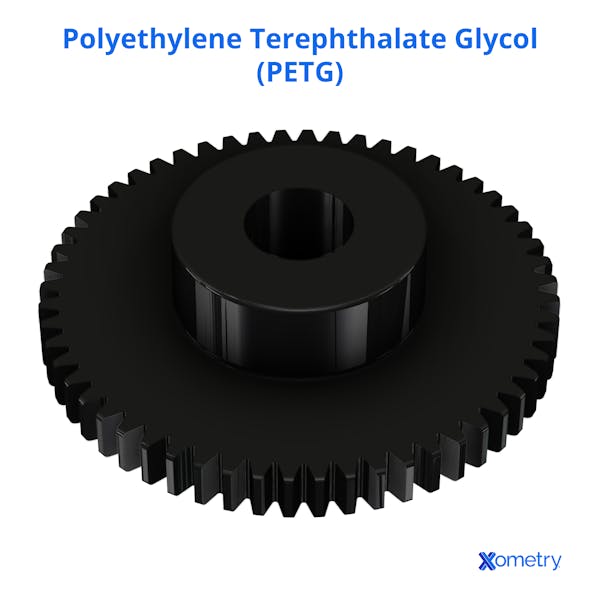Polyester is the third most widely used synthetic plastic by production volume, extensively applied in clothing, food packaging, industrial films, and automotive components. It is known for its excellent mechanical strength, chemical resistance, wear resistance, and electrical insulating properties. Polyester typically has a melting point around 246 °C, depending on the specific grade. Polyester, most commonly polyethylene terephthalate (PET), is synthesized from terephthalic acid and ethylene glycol [ethane-1,2-diol] through a condensation polymerization process.
Polyester can be processed into fibers using extrusion, but can also be injection molded to produce parts with an exceptional surface finish.
This article will cover what polyester is, the history of its invention, and its key advantages, disadvantages, typical applications, and health and environmental considerations.
What Is Polyester?
Polyester is a very durable plastic that is most commonly used in fiber form for clothing. It is the third most widely used commodity plastic. Polyester is a long-chain polymer composed primarily of ester functional groups and terephthalic acid.
A common trade name for polyester is Terylene. Polyester is further categorized by its chemical makeup as described below:
- PET (Polyethylene Terephthalate): This is the most commonly used grade of polyester, known by the following trade names: Mylar®, Rynite®, and Impet®.
- PBT (Polybutylene Terephthalate): PBT has a lower melting temperature than PET and improved chain flexibility.
- PEN (Polyethylene Naphthalate): PEN has low oxygen permeability. It is used in packaging applications where the product is susceptible to oxidation.
- PTT (Polytrimethylene Terephthalate): This grade is commonly used in the textiles industry due to its stain resistance and durability.
How Polyester is Made?
Polyester plastic is formed by combining two monomers: a dicarboxylic acid and a diol. More specifically, PET is a condensation polymer manufactured by combining terephthalic acid with ethylene glycol (not ethane-1,2-diol). The product of this reaction is polyester and water. The polyester is then either processed into fibers for fabrics or pellets for use in injection- or blow-molding applications.
When was Polyester Invented?
Polyester was first explored in the early 1930s by W.H. Carothers and his research team at DuPont, who investigated synthetic polymers. However, Carothers primarily focused on polyamides (leading to the invention of nylon), and polyesters were not further developed at DuPont during that period. The significant breakthrough in polyester fiber development came in 1941, when British chemists John Rex Whinfield and James Tennant Dickson, working at the Calico Printers' Association, successfully synthesized polyethylene terephthalate (PET), which is the basis for modern polyester fibers. They patented the material, which was later licensed by DuPont. DuPont subsequently commercialized it under the brand names Dacron for fibers and Mylar for polyester film.
How is Polyester Used in Plastic Injection Molding?
Polyester is widely used in injection-molding applications and can be processed like any other injection-moldable thermoplastic. Standard PET, PETG, and PBT are all easily injection molded and produce an excellent surface finish. Polyester resins readily accept minerals and glass reinforcing fillers, which are used to improve the overall mechanical performance of injection-molded polyesters.

| Property | Value |
|---|---|
Property Density (g/cm3) | Value 1.33 |
Property Hardness (Shore D) | Value 81.2 |
Property Ultimate Tensile Strength (MPa) | Value 49.2 |
Property Yield Strength (MPa) | Value 61.8 |
Property Elongation @ Break (%) | Value 82.9 |
Property Flexural Yield Strength (MPa) | Value 82.1 |
Property Melting Point (°C) | Value 246 |
Property Heat Deflection Temperature @ 0.46 MPa (°C) | Value 90.8 |
Property Heat Deflection Temperature @ 0.8 MPa (°C) | Value 72.3 |
Property Flammability (UL94) | Value HB-V-0 [varies by grade] |
Table 1: Key Physical Properties of PET
What are the Uses of Polyester?
Polyester is widely used in the textile industry and injection-molding applications. It can be processed like any other injection-moldable thermoplastic. Standard PET, PETG, and PBT are all easily injection molded and produce an excellent surface finish. Polyester resins readily accept minerals and glass reinforcing fillers, which are used to improve the overall mechanical performance of injection-molded polyesters. Examples of its applications are listed below:
- Fibers: Polyester material has high strength and is used in clothing and conveyor belt/car tire reinforcing fabrics.
- Automotive Components: Alternator housings, structural automotive parts, and fog lamps are some common examples of how polyester is utilized for automotive applications.
- Electrical: Circuit breakers can be manufactured from PBT due to the material's dimensional stability and low moisture absorption. Polyester can also be used for insulation tape and as insulation for electrical cables.
- Medical: Polyester is used to create blister packs for packaging medications.
For more information, see our guide on the Uses of Polyester.
What are the Advantages of Polyester?
Polyester is a widely used polymer, valued for its high tensile strength and durability, particularly in the form of fabrics and films. It is inherently hydrophobic, meaning it resists absorbing water, contributing to quick-drying properties and moisture-wicking performance—qualities that make it well-suited for apparel and activewear. Polyester is also chemically resistant to many substances, including most acids and oxidizing agents. However, it can be degraded by certain solvents, such as trichloromethane mixed with phenol, and by strong alkaline solutions, especially at elevated temperatures. Polyester is a low-cost alternative to engineering polymers such as nylon, particularly in applications where high strength is needed without the expense of specialty materials. In addition to its chemical resistance, polyester is a good electrical insulator and exhibits good wear and abrasion resistance.
What are the Disadvantages of Polyester?
While polyester offers many practical advantages, it also has notable disadvantages that must be considered. One of the primary concerns is its environmental impact. The production of polyester is energy-intensive and heavily reliant on fossil fuels. On average, producing one kilogram of polyester fiber generates approximately 14.2 kilograms of carbon dioxide equivalents, although this figure can vary depending on the energy source and production methods used. This makes polyester one of the more carbon-intensive materials in the textile industry. In terms of safety, polyester presents a thermal hazard. Although it has a relatively high ignition temperature of around 432°C (810°F), it melts at lower temperatures, typically between 255°C and 265°C (491°F to 509°F). When exposed to an open flame, the material can melt and stick to the skin, causing serious burn injuries. This behavior is essential to consider in environments where fire resistance is critical. Another drawback is polyester's tendency to accumulate static electricity. Despite being an electrical insulator, its low moisture absorption rate means it can easily build up static charge. This can lead to dust attraction and may pose a risk to sensitive electronic components if antistatic precautions are not taken.
Frequently Asked Questions About Polyester
How Does Polyester Affect Human Health?
Polyester fabric is a widely used material for consumer clothing and, as such, comes into direct contact with the skin. Polyester can cause skin irritation in individuals with sensitive skin, but it is not considered a material that produces allergic contact dermatitis. Polyester cannot be inhaled, and only processing fumes developed during the melt processing can irritate the nose and throat.
Is Polyester Toxic?
Polyester is not toxic in its solid, finished form and is safe for typical use in textiles and packaging. However, during manufacturing or if burned, it can release harmful fumes, including volatile organic compounds and toxic gases like carbon monoxide. These byproducts can pose health risks if inhaled.
Is Polyester Plastic?
Polyester is a plastic and the third most widely used commodity plastic. More specifically, polyester is a thermoplastic processed by melting it in pellet form and extruding it into fibers, or injecting it into molds using standard melt processing techniques.
Summary
This article provided a summary of polyester's properties, applications, advantages, types, and toxicity.
Xometry offers injection molding services for all of your prototyping and production needs. Visit our website to learn more about our manufacturing capabilities and to request a free, no-obligation quote using our Instant Quote Engine.
Copyright and Trademark Notices
- Mylar® is a registered trademark of DuPont Teijin Films, Chester, VA.
- Rynite® is a registered trademark of E.I. Du Pont De Nemours and Company, Wilmington, DE.
- Impet® is a registered trademark of CNA Holdings LLC, Irving, TX.
- Dacron® is a registered trademark of E.I. Du Pont De Nemours and Company, Wilmington, DE.
Disclaimer
The content appearing on this webpage is for informational purposes only. Xometry makes no representation or warranty of any kind, be it expressed or implied, as to the accuracy, completeness, or validity of the information. Any performance parameters, geometric tolerances, specific design features, quality and types of materials, or processes should not be inferred to represent what will be delivered by third-party suppliers or manufacturers through Xometry’s network. Buyers seeking quotes for parts are responsible for defining the specific requirements for those parts. Please refer to our terms and conditions for more information.


